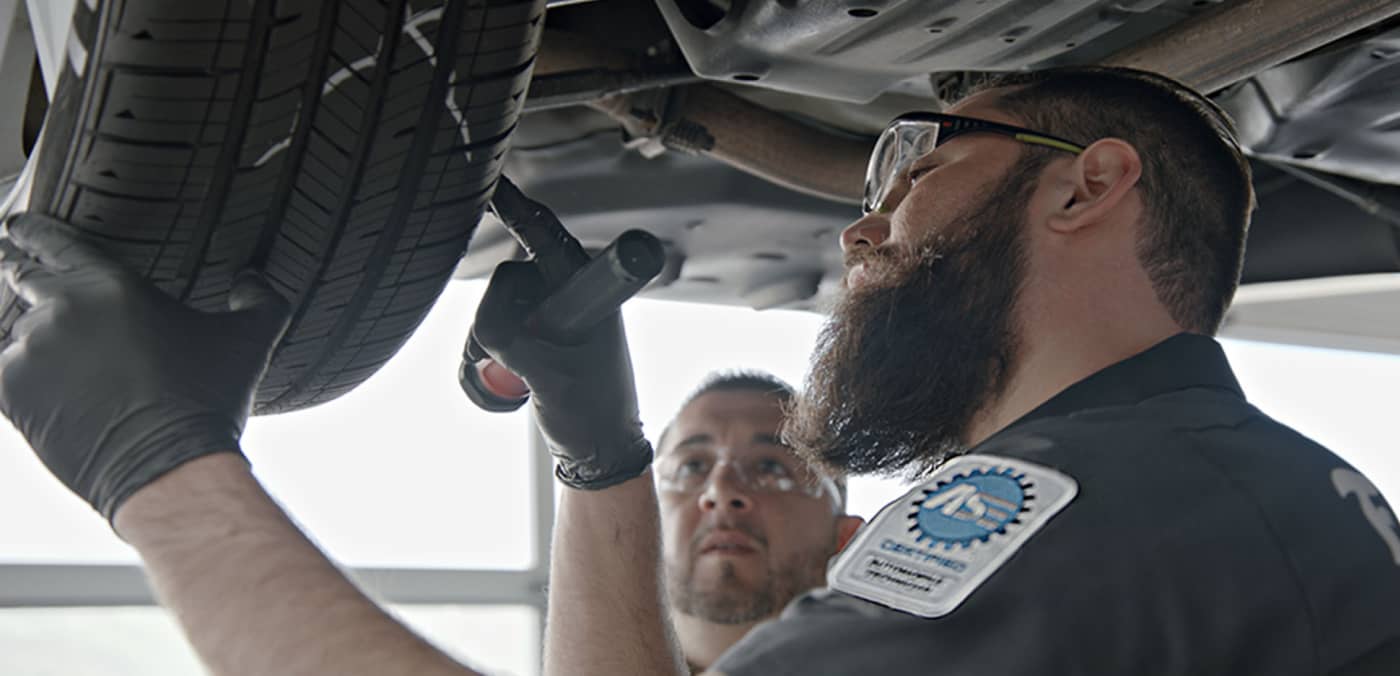Do your tires’ tread have some spots that are worn unevenly, or more heavily than the surrounding tread? If so, your tires may be showing evidence of a type of erratic treadwear referred to as “cupping”.
WHAT IS TIRE CUPPING?
Tire cupping can appear as if someone took an ice cream scoop and scooped out part of the tread every three to four inches around the circumference. Due to the shape of the worn places, tire cupping is sometimes also referred to as “scalloped tires.”
Knowing the causes, related issues, and how to prevent tire cupping can help vehicle owners save money and reduce the inconvenience of unexpected repairs.
CAUSES OF TIRES CUPPING
Tire cupping can be a symptom of a variety of suspension issues. Getting them corrected promptly can help owners avoid extra tire and repair expense.
Misaligned Tires
Misaligned tires’ contact with the road may be uneven, or they may not be rolling straight. The uneven stresses on the tire caused by these conditions may show on the tread as cupping, or a “sawtooth” wear pattern at the edges of the tread - “heel-toe wear” in engineering-speak.
Worn Suspension and Shocks
Suspension components like shock absorbers, struts, bushings and others wear out with miles travelled. The result can be a tire that is no longer able to roll smoothly down the road; instead, it bounces slightly. This bouncing creates uneven points of pressure on tires, leading to tire cupping.
Unbalanced Tires
If weight across the circumference of a tire is not evenly distributed, it could lead to unbalanced tires. If severe enough, an out-of-balance condition can cause some sections of the tread to meet the road with greater force than others. This increased force results in greater wear in those areas - tire cupping or erratic treadwear.
Tires need to be well maintained to ensure a safe driving experience, and if they are unbalanced, have them checked by a certified mechanic. Merely having tires balanced can extend their life up to 20%.
Cheap Tires
Not all tires are equal in quality. Some may use lower-quality materials (steel belts that provide less support for the tread, rubber that is more prone to wear unevenly, etc.). These tires may be more susceptible to cupping on a vehicle with a worn suspension or less-than-perfect wheel balance.
THE PROBLEM WITH TIRE CUPPING
Tire cupping is not something that should be taken lightly and ignored. If allowed to continue, cupping will worsen, resulting in other problems.
Inconsistent Contact
Tires are designed so that their tread is in continuous contact with the surface of the road when driving. Cupped tires interrupt this consistency because the patches create uneven high and low points of the tread that don’t allow continuous contact. This can reduce traction in an emergency, increasing the risk of a loss of vehicle control.
SIGNS OF TIRE CUPPING
Drivers experiencing these signs need to have their vehicle’s tires and suspension checked by a trusted professional.
Vibrating and Shaking
A possible sign that tires are unbalanced and potentially cupping is if the steering wheel or seat is shaking or vibrating.
Vibrating felt through the steering wheel means the front wheels may be unbalanced, and vibrating felt through the seat means the back wheels could be unbalanced. If vibrating is felt through both the seat and steering wheel, it is crucial to have tires checked for imbalances and possible cupping.
Tire Noise
Cupped tires tend to be quite noisy, especially at highway speeds. If you experience increasing tire noise over time, be sure to have them inspected by a professional.
Veering Vehicle
Misaligned tires may cause a vehicle to drift to the left or right or behave unpredictably when turning. Tire cupping can be the result of misaligned and/or unbalanced tires. If you notice any of these conditions when driving, have your vehicle’s tires and alignment checked by a qualified technician.
Visual Signs
Tire cupping can be seen on tires. Take a quick look at the tire’s tread, and if there are uneven scooped patches of worn tread, have it replaced.
PREVENTING TIRE CUPPING
Staying safe when driving is paramount. Preventing tire cupping helps keep drivers and others safe on the road, plus helps to avoid potential repair costs. So how can tire cupping be prevented?
Timely maintenance keeps expenses low, tire health high, and can help you avoid unexpected repair bills. The following are several areas to consider keeping your tires at their best:
Rotating and Balancing
Having tires rotated and balanced regularly helps your tires last and deliver optimal performance. Generally, tires need to be rotated every 5,000 to 8,000 miles and re-balanced with every other rotation.
Alignment and Suspension
Having the alignment and suspension checked yearly reduces the likelihood of tire cupping by ensuring the tire rolls the way it was intended to by the car maker, and is in full contact with the road at all times.
Air Pressure
Check tire air pressure monthly. This helps identify if one tire is losing air quicker than others and prevents driving on underinflated tires, which contributes to various forms of increased tire wear, including cupping.
For a vehicle to be at peak performance, its component parts must work properly, especially its tires. If you believe your tires are experiencing cupping, have them checked and possibly replaced to ensure safety for you and others on the road.



